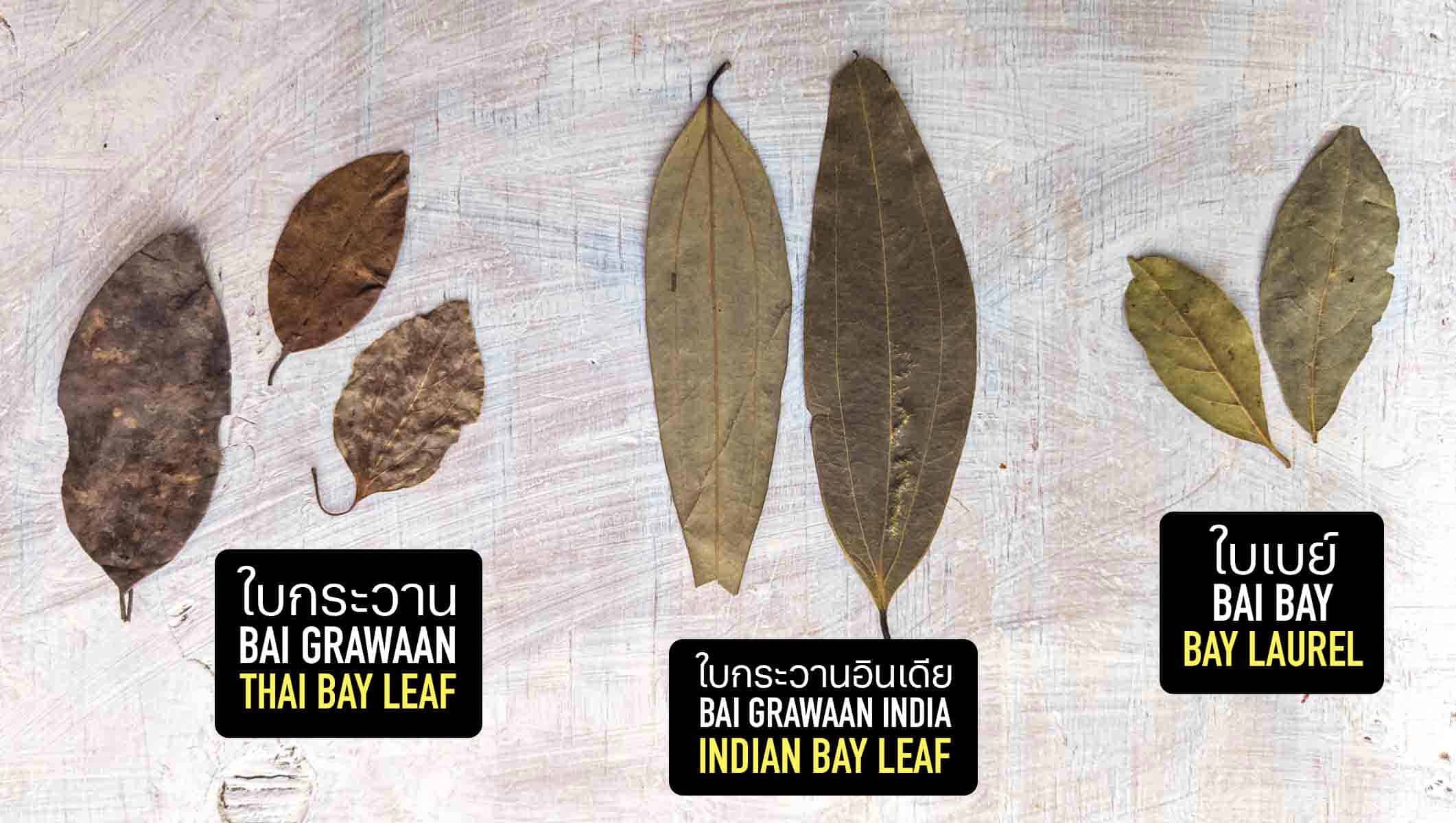I sometimes come across Thai recipes that include bay leaves and, given I already know there are different varieties around the world, I wondered how Thai bay leaves differ from the other two with which I have familiarity: bay laurel (laurus nobilis) and Indian bay leaves (cinnamomum tamala).

So, if you've ever wondered about Thai bay leaves in curry (especially massaman) and dishes like khao mok (Thai biryani), hopefully this post will answer any questions.
The results from tasting all three bay leaves
After reading a lot of conflicting information, I decided to conduct a small experiment. In my test I placed one leaf of each bay laurel, tej patta, and bai grawaan in small bowls, into which I poured 45 millilitres of boiling water. After a 15 minute covered period, I tasted the water from each bowl in order to see what flavours came through.
The differences between the three were great. The bay laurel leaf tasted as expected: camphorous and piney. The Indian bay leaf was redolent with cinnamon notes (cinnamaldehyde is the main compound behind the aroma). Thai bay was something else altogether, and I couldn't put my finger on it even though the flavour was familiar to me.
And so I looked toward my library and the less reliable internet for answers. Here's a summary of what I knew already and what I learned.
In Thai, bay leaves are called bai grawaan ใบกระวาน and come from the evergreen thep taro tree (ต้นเทพทาโร), or cinnamomum parthenoxylon. Some Thais claim the dried leaves smell like Siam cardamom, a common ingredient in some Thai curries, and so they may be used in place of or to enhance this flavour. This begins to make some sense when you look to the name of Thai/Siam cardmom: luk grawaan (for reference, bai means leaf and luk is a reference to the round shape of Thai cardamom).
You may have guessed by now that bai grawaan is not same as the bay laurel we use in Western cooking (bai bay ใบเบย์), nor is it the same as the Indian bay leaf (also called tej patta).
Like with bay laurel, you'll find some camphor-like notes in Thai bay, though far less. More noteable are the aromas produced by a major component molecule called safrole. This emits sassafras-like smells, similar to Mexican pepperleaf (hoja santa). Those unfamiliar with either should recall the flavour of root beer, which used sassafras as its main flavouring agent until the 1970s. Nowadays root beer typically uses synthetic safrole, but the olfactory profile is the same.
Outside of Thailand you'd hardly know such a thing as a Thai bay leaf exists. Indeed, at least to some extent, the lack of awareness appears to exist within Thailand as well. In all of the cooking volumes I own in English, not one author notes a difference when they call for bay leaves. Even in Thai there is confusion.
Much of the information I've found online in Thai language conflates bay laurel with Thai bay leaves. Many native speakers regularly specify that bai grawaan is, in fact, bay laurel. In practice I suspect the misconception has no consequences in the sense that whichever bay leaf you use wouldn't ruin a dish, and consequently this has led to the lack of general investigation. As mentioned, in the myriad English language Thai cookery volumes I own, all call for bay leaves but don't specify a variety.
Where can I buy Thai bay leaves?
You would be hard-pressed to find this outside of Thailand. I've not seen them for sale anywhere in London. That doesn't mean they're available outside of Thailand, but you'll have a tough time finding them. If you find yourself in Bangkok, you'll probably have luck picking up a bag at a regular grocery story. I got mind at Foodland.
Though I have yet to try this myself, I wager a good substitute for Thai bay leaves would be bay laurel combine with a very small amount of hoja santa.